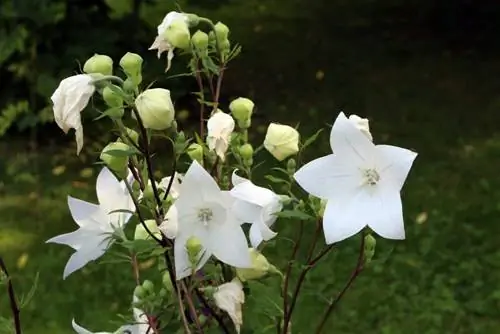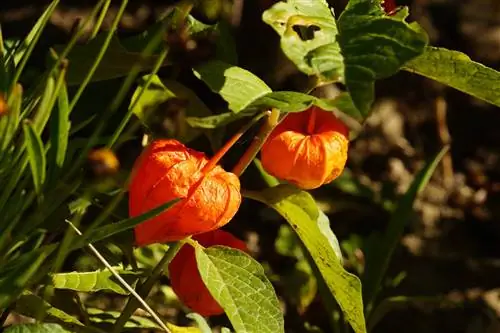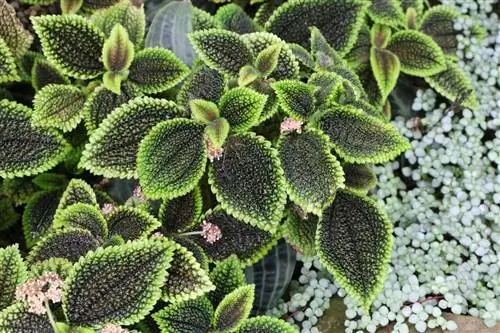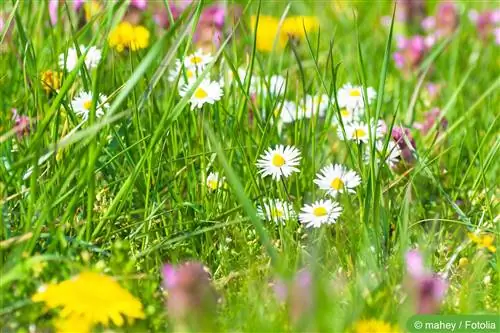- Author admin [email protected].
- Public 2023-12-17 03:39.
- Last modified 2025-01-24 12:45.
In the colorful array of hardy flowering perennials, the balloon flower is already causing a sensation with its spherical buds. It seems as if they wanted to rise from the stem like little balloons. Instead, magnificent bell-shaped flowers in bright blue, pure white or delicate pink unfold in July and August. With its Asian charm, the herbaceous flower beauty prefers rock gardens, light perennial borders and the balcony. Was the Chinese bellflower still missing from your creative planting plan? Then you will find out everything about care, propagation and overwintering below.
Location
In order for the balloon flower to develop its pretty flower bouquet to perfection, the first thing to consider is a location with at least 3 hours of sunshine per day. This requirement implies that the perennial does not rely on a constant spot of sunshine. This is primarily appreciated by hobby gardeners who don't want to be out and about with a watering can several times a day during warm summer days. These location conditions are important:
- Sunny to semi-shady location
- Protected from strong winds and pelting rain
- Warm and without a cool draft
Since a Chinese bellflower anchors itself in the ground with deep taproots, the location needs to be chosen carefully. The perennial sometimes reacts a little angrily to a later transplant.
Tip:
White-flowering balloon flower varieties prefer a place in partial shade, as the pure white flowers could change color under direct sunlight.
Soil conditions and substrate
With regard to the bed soil and the substrate in the pot or balcony box, a Platycodon can be satisfied quickly. If she finds the following conditions, she will happily stretch out her roots:
- Loamy-sandy garden soil
- Nutritional and humic
- Sandy-gravelly rock garden soil is accepted
- Well drained without risk of waterlogging
A mixture of potting soil and sand is recommended in the planter. The addition of perlite, expanded clay or lava granules makes a valuable contribution to permeability, as commercially available balcony soil tends to compact.
Watering and fertilizing
The better the location and soil take into account the requirements of a balloon flower, the easier it is to care for.
- Keep the soil constantly moist in the bed
- Allow the soil to dry between waterings
- Determine the daily watering requirement in the bucket and balcony box using a thumb test
- Administer liquid fertilizer for flowering plants every 4 weeks from April to August
- Balloon flowers in nutrient-rich garden soil do not necessarily need to be fertilized
- In the summer, occasionally work a portion of compost into the soil
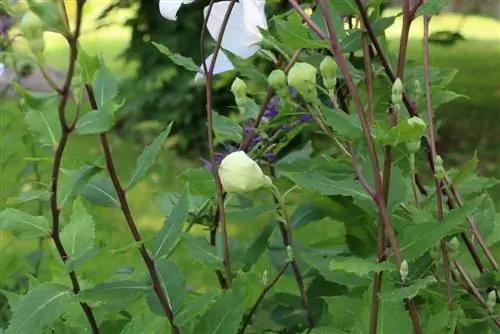
Immediately after planting, the water requirement of a Platycodon is higher so that it can become well established in the location. The substrate surface should always dry during this phase before you water the next time. Ideally, you should avoid watering leaves and flowers and water directly to the root area.
Tip:
Regular watering with pond water eliminates the need to add fertilizer to a balloon flower.
Cutting
Immediately after flowering, the balloon flower begins to pull in its above-ground plant parts from August/September. As part of this process, the plant draws in the remaining nutrients to feed on during the winter. As long as the withered leaves and flowers do not affect the visual appearance of the garden, they should remain on the perennial throughout the winter as they also act as natural winter protection.
- Cleaning out the balloon flower regularly in July and August attracts new flowers
- If seeding is not desired, dried flowers are cut off immediately
- Cut the perennial close to the ground in early spring at the latest
As Georgetown University in the USA found out, the roots and leaves can be poisonous. It is therefore advisable to wear protective gloves for all planting and care work. The clippings should also not be disposed of on a meadow with grazing animals.
Propagate
In view of the beautiful flowers and the low maintenance requirements, the balloon flower makes hobby gardeners want more specimens. There are two approaches to choose from for propagation, which are explained below. It is important to decide in advance whether pure breeding is desired or whether the result should be a surprise. If you decide to sow and collect the seeds yourself, Platycodon varieties do not provide pure seeds. However, if you prefer vegetative propagation through division, the new flower will develop exactly the attributes of its mother plant.
Sowing
After flowering, small capsules form which, when dried, contain numerous seeds. However, do not wait too long before harvesting so that the capsules do not burst open and the seeds scatter to the four winds. Stored in a dark screw-top jar in a cool place, the seeds will be stored until mid/end of February. This is how sowing works:
- Fill a seed tray with peat sand or lean herb soil
- Moisten the substrate with a fine spray
- Spread the seeds on top and press just a little to ensure light germination
- Covered with glass or foil, place in a partially shaded window seat
- At temperatures of 16 to 21 degrees Celsius, germination begins within 3 to 4 weeks
When the first cotyledons appear, the cover has fulfilled its duty. While more leaves develop, the substrate must not dry out. Once they reach a height of 5 centimeters, the seedlings are transplanted into individual pots. The substrate can now be a little more nutrient-rich, such as a potting soil and sand mixture or commercially available potting soil. The time window for planting in the bed and on the balcony opens in early to mid-May.
Division
A sufficiently established balloon flower is suitable for propagation by division from the fourth year onwards. The weeks from early March to mid-April are the best time to do this, provided the ground is not frozen. How to do it right:
- Loosen the perennial all around with the digging fork
- Lift it out of the ground and break it up with a spade
- Each segment has at least two buds
In the new location, plant the sections exactly as deep as they were previously in the ground. Ideally, you enrich the soil with compost and horn shavings. Repeated watering is required in the first few days and weeks to ensure that the Chinese bluebells grow well.
Wintering

The balloon flower is frost-resistant down to -20 degrees Celsius. A normal winter cannot harm it in this latitude, so no special precautions are necessary. During the year of planting, it is nevertheless an advantage to protect the young perennial with a layer of compost or leaf mold. Since the root ball in the planter is exposed to the risk of freezing in temperatures below zero, the following precautions should be taken:
- Cover the pot or balcony box with bubble wrap or garden fleece
- Cover the substrate with straw, brushwood or leaf mold
- Place planters in front of the protective house wall, on a wooden or Styrofoam block
Permanent frost without snow can lead to drought stress in a Platycodon. Therefore, water the perennial on frost-free days both in the bed and in the bucket or flower box.
When the mercury column exceeds zero degrees in spring, all winter protection is removed in good time so that no mold or rot can form underneath.
Other interesting facts
The balloon flower is used in herbal medicine. In its countries of origin it is used in many ways. Its roots in traditional Chinese medicine are used to stimulate the immune system and against cancer.
Various dishes are also prepared with the balloon flower. The young leaves are eaten cooked, for example. The older leaves, on the other hand, are said to be poisonous. They are dried and used for seasoning.
The roots of the balloon flower are used like vegetables. They are mainly added to the soup as a strengthening vegetable. Another way to use it is to peel and acidify the roots, which are then preserved in sugar. In Korea, the presence of balloon flower roots is revealed by the term bellflower roots. But it's better not to try out whether the balloon flowers from the garden are suitable for consumption.
Conclusion
With its balloon-like buds and enchanting bell-shaped flowers, the balloon flower creates a colorful appearance in the bed and on the balcony for many years. Once the hobby gardener has learned everything about care, propagation and overwintering, the decision in favor of the Asian perennial is no longer difficult. By choosing a sunny to partially shaded location, in conjunction with nutritious, permeable soil, half of the care requirements are already met. Regular watering and a little fertilizer complete the cultivation. Propagation by sowing or division is just as straightforward. Even overwintering this frost-resistant flower beauty does not pose any significant challenge.

